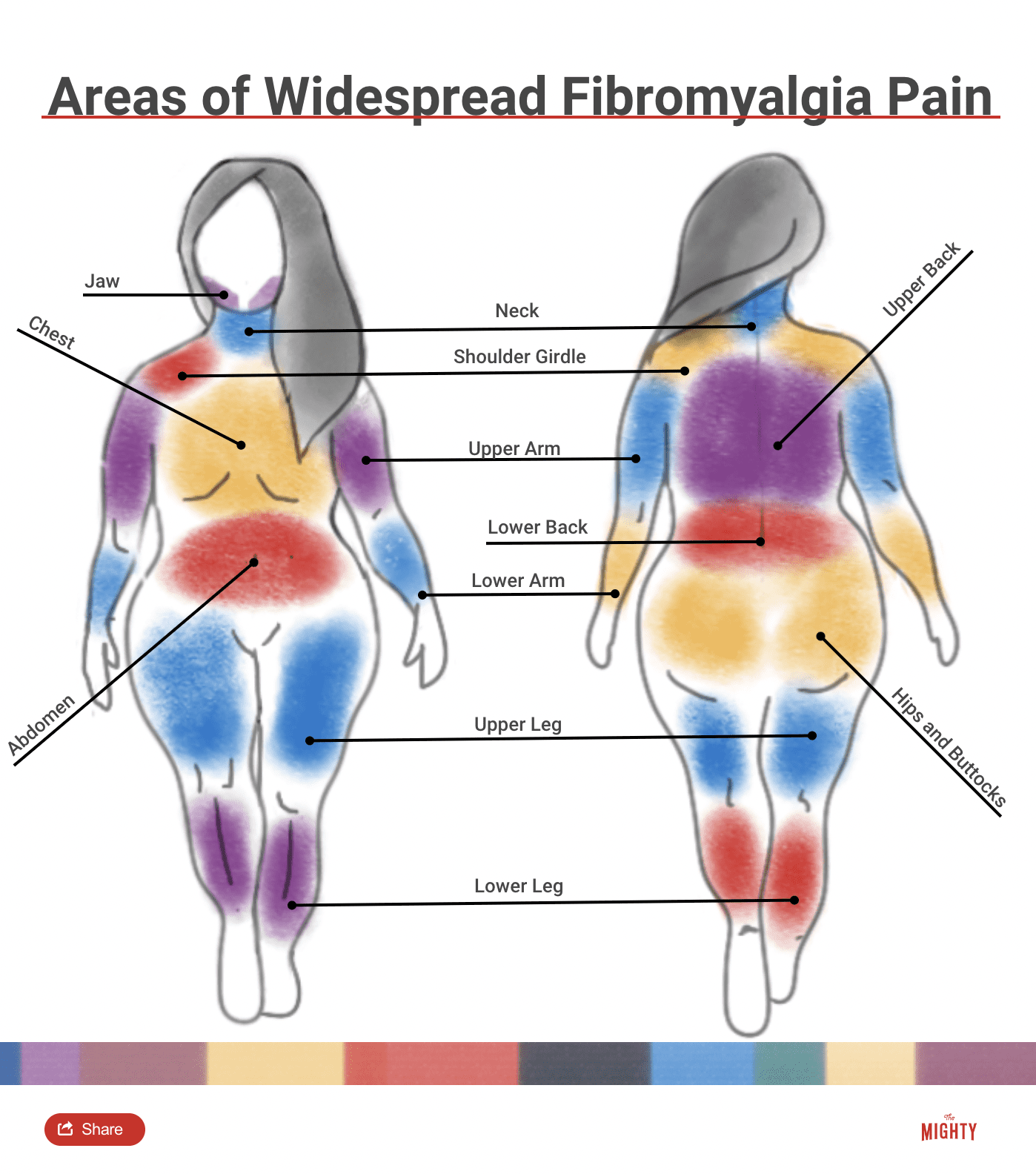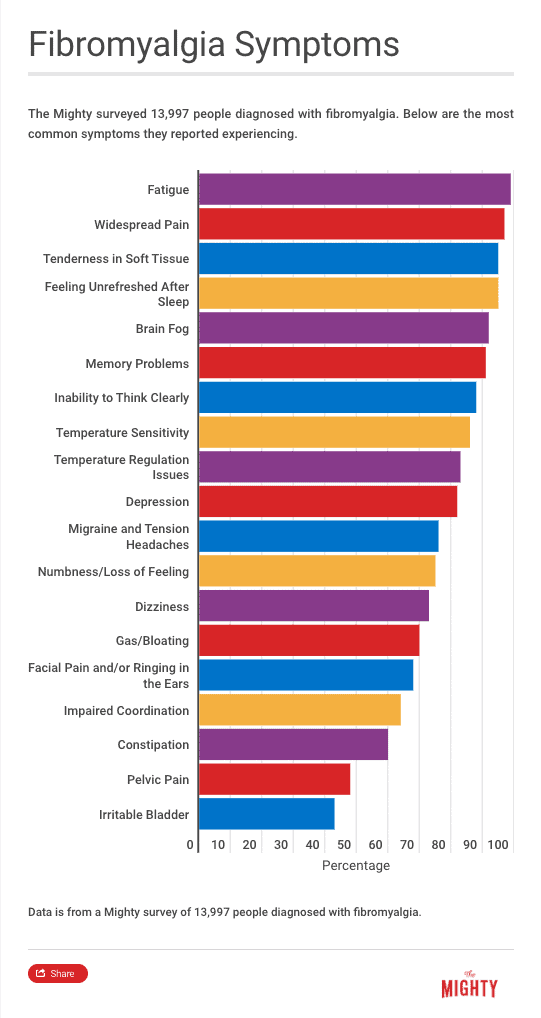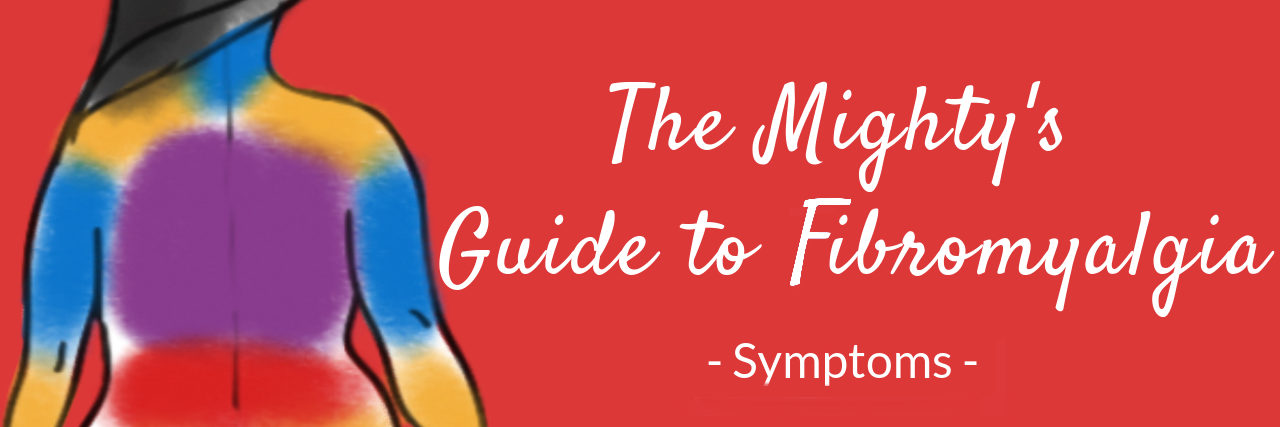Symptoms of Fibromyalgia
Editor's Note
The Mighty’s Condition Guides combine the expertise of both the medical and patient community to help you and your loved ones on your health journeys. For the fibromyalgia guide, we interviewed five medical experts, read numerous studies and surveyed 13,997 people diagnosed with the condition. The guides are living documents and will be updated with new information as it becomes available.
Learn More About Fibromyalgia: Overview | Diagnosis | Treatment | Resources | Related Conditions

Medically reviewed by Emma Guymer, MBBS, FRACP
Common Fibro Symptoms | Somatic Dysfunction | Mental Health Symptoms | What Causes a Fibro Flare | Symptoms in Children and Adolescents
Understanding Fibromyalgia: What Does Fibromyalgia Feel Like?
Fibromyalgia is a chronic illness that affects about 3 to 6 percent of the general population. Though it’s still not well understood, fibromyalgia seems to be caused in large part due to an overly active nervous system that keeps you in fight-or-flight mode. Your system isn’t designed to stay “keyed up” like this for long amounts of time, which leads to a variety of fibromyalgia symptoms.
While fibromyalgia is a serious illness without a cure, it does not lead to heart attack, stroke, cancer or physical deformities. As debilitating as the condition can be, it is not fatal.¹
Most Common Fibro Symptoms
The three most common symptoms of fibromyalgia are:
- Widespread pain
- Fatigue
- Cognitive difficulties like brain fog
You may also experience other symptoms such as digestive trouble, bladder issues and temperature and sensory sensitivity. It’s also possible to have other conditions in addition, including autoimmune disorders and mental illness.
Widespread Pain
The hallmark of fibromyalgia is widespread pain. Unlike arthritis, where you experience pain in your joints, you’ll feel most fibromyalgia pain in your muscles. This is where the name comes from — fibro, like fibrous tissues, which include muscles, tendons, ligaments and fascia, a connective tissue that covers and separates your organs.
Fibro pain is often described as achy. It occurs all over your body, not just in one area.² This could include pain in your:
- Arms
- Shoulders
- Legs
- Hips
- Back
- Neck
- Abdomen
- Chest
- Jaw
If you’re not sure where you’re having pain, you can check for tender points by gently applying pressure to these areas of your body. When you apply pressure you may feel moderate to severe pain.

Related: Here are some ways people describe what it’s like living with fibromyalgia.
- “How I Describe Fibromyalgia to People Who Have Never Felt It“
- “18 Types of Pain I Experience With Fibromyalgia“
- “30 Things Only People With Fibromyalgia Tend to Understand“
Fatigue
Fatigue is sleep that doesn’t make you feel refreshed when you wake up. You won’t feel better even with 10 or more hours of sleep because you’re not getting deep sleep. To get restorative sleep, you need to reach a deep stage three and four delta wave sleep and rapid eye movement (REM) sleep. Because fibro causes your sympathetic nervous system to stay locked in a hypervigilant state, it’s hard to reach deep sleep because your body wants to stay alert in case of a threat. Fatigue makes it hard to do daily activities because you don’t have the energy.
Issues With Cognitive Functioning
Fibromyalgia can cause cognitive issues like “brain fog.” It may be difficult to pay attention or find the right words. Your short-term or long-term memory can be affected, making it hard to recall information. Some studies show that people with fibromyalgia scored as if they were 20 years older than they really are on verbal skills tests. Fibromyalgia can affect your ability to think, remember and communicate verbally.6 Similar difficulties may be caused by an underlying mental illness, like major depressive disorder, so it’s important to rule out other comorbid conditions.

Somatic Dysfunction
Fibromyalgia leads to a category of symptoms called somatic dysfunction, which occurs when systems in your body don’t work as they should. This includes digestive and gastrointestinal tract (GI) issues like constipation or diarrhea and irritable bowel syndrome (IBS). Bladder pain is common, and people born female may experience issues with their reproductive organs.4 You may feel dizzy, tingly or shaky, feel sensitive to sound, smells, light and temperature and lose feeling in your feet.³
Other symptoms reported by the 13,997 people who took The Mighty’s fibromyalgia survey include:
- Burning/zapping pain
- Chest and rib pain including costochondritis
- Dizziness
- Dry mouth
- Eye pain and/or vision issues
- Excessive sweating (hyperhidrosis)
- Feeling lightheaded and/or fainting
- Hair loss
- Insomnia
- Loss of Coordination
- Nausea
- Painful intercourse
- Sensory and/or chemical sensitivities
Related: Here are some ways people describe what it’s like living with fibromyalgia.
- “What Sleeping Is Like When You Have Fibromyalgia“
- “I Finally Know Why I Have Difficulty Speaking With Fibromyalgia“
- “17 Side Effects of Fibromyalgia We Don’t Talk About – in Photos“
- “16 Photos That Show How Fibromyalgia Can Affect Your Skin“
Mental Health Symptoms
Fibromyalgia symptoms sometimes resemble mental illness. It’s not uncommon to experience depression, nervousness or anxiety that’s a symptom of fibromyalgia, likely because of how the condition impacts your nervous system.7 Fibromyalgia can also make you more likely to develop a separate mental health condition in addition to fibro.
For example, there’s a significant overlap between post-traumatic stress disorder (PTSD) and patients with fibromyalgia.5 The connection between fibro and PTSD is not well understood, but because both conditions are connected to a fight-or-flight reaction in your nervous system and both can be triggered by trauma, there are likely many similarities between both conditions. Depression and anxiety disorder are also common if you have fibro.


What Causes a Fibro Flare
Your fibromyalgia symptoms may flare at times. A flare-up means your symptoms are worse than usual for a period of time and can occur after days, weeks or even months of feeling relatively fine. Flare-ups can last from days to months and can be debilitating. Flares seem to occur at particular times, such as when people menstruate. The morning might be more difficult than later in the day. You may have a flare immediately following an unrelated surgery or in situations of increased physical or psychological stress.
It’s also common that your condition flares based on weather, temperature and seasonal changes. For example, your symptoms may be better in the late spring and summer months when it’s warmer and by the fall and winter as the temperature drops, your symptoms flare. Your flares can be sensitive to increases in atmospheric pressure, causing you to experience pain when it rains, for example.
Related: Here are some ways people describe what it’s like living with fibromyalgia.
Symptoms in Children and Adolescents
Fibromyalgia is not typically diagnosed in children, but it is being recognized more frequently in adolescence. As fibromyalgia awareness catches up in the medical community, there are few pediatricians familiar with the symptoms. Therefore, while diagnosis in young people is improving, more teenagers likely have the condition than are diagnosed. Often when teenagers report fibromyalgia symptoms, they’re dismissed as growing pains, depression or “adolescent angst.”5 Adolescents experience the same symptoms as adults.
Learn More About Fibromyalgia: Overview | Diagnosis | Treatment | Resources | Related Conditions


Sources
- Bhana, S. (2017). Fibromyalgia. Retrieved from https://www.rheumatology.org/I-Am-A/Patient-Caregiver/Diseases-Conditions/Fibromyalgia
- Brady, D. (2018). Fibromyalgia [Telephone interview].
- D’Arcy-Sharpe, A. (2018, May 30). 10 Lesser-Known Symptoms of Fibromyalgia I Experience. Retrieved from https://themighty.com/2018/05/fibromyalgia-symptoms-less-known/
- Gerwin, R. D. (2018). Fibromyalgia [Telephone interview].
- Liptan, G. (2018). Fibromyalgia [Telephone interview].
National Fibromyalgia & Chronic Pain Association (NFMCPA). (n.d.). Retrieved from https://www.fmcpaware.org/ - Wolfe, F., Clauw, D. J., Fitzcharles, M., Goldenberg, D. L., Katz, R. S., Mease, P., . . . Yunus, M. B. (2010).
- The American College of Rheumatology Preliminary Diagnostic Criteria for Fibromyalgia and Measurement of Symptom Severity. Arthritis Care & Research,62(5), 600-610. doi:10.1002/acr.20140

